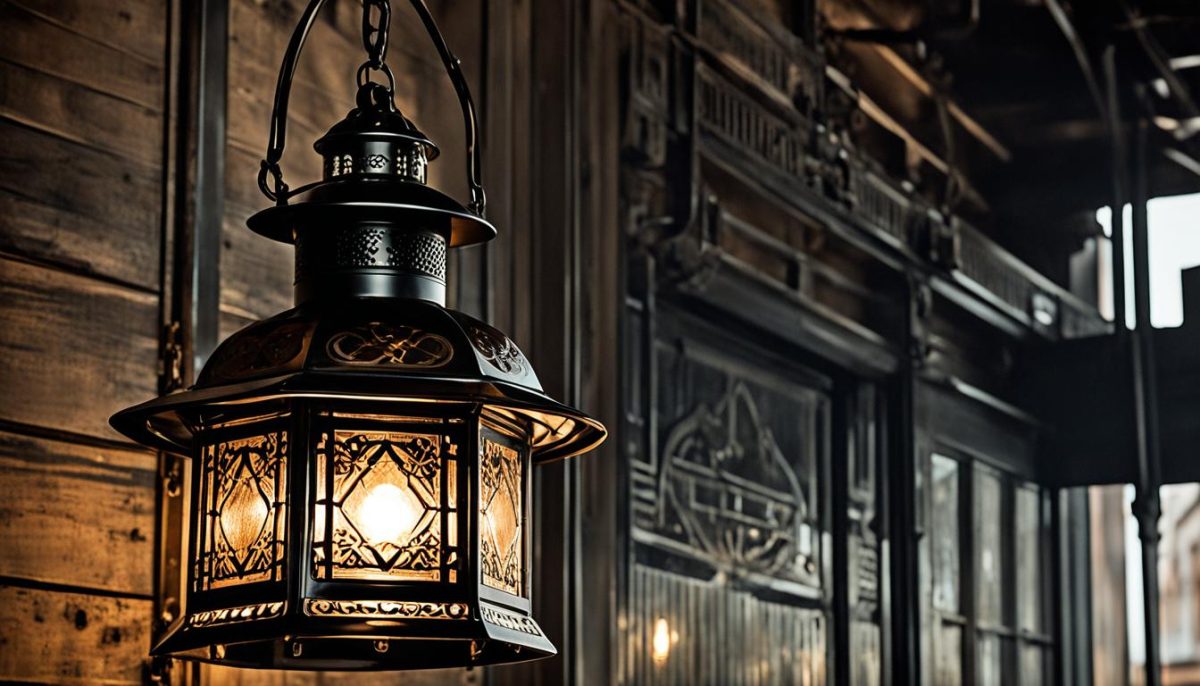Steeped in the rich tapestry of the railway system’s past, vintage railroad lanterns herald a bygone era of hands-on ingenuity and signaling skill. These historic railroad lamps, cherished as railway lantern collectibles, continue to captivate enthusiasts and historians alike. Their warm glow is a testament to the days of steam engines and the tireless work of railroaders, ensuring safe passage on treacherous tracks. The allure of antique train lanterns beckons a closer look into their history, shedding light on their essential role in a transformative age of transportation.

Create an image of vintage railroad lantern lamps hanging from a wooden beam, their warm orange light casting shadows on the worn surface below. The lamps are rusted and weathered, showing signs of use and age, but their intricate details and craftsmanship still shine through. A sense of history and nostalgia is palpable in this scene, as if the lanterns have witnessed countless journeys and adventures over the years.
The Historical Significance of Vintage Railroad Lantern Lamps
The intricate tapestry of railroad communication history is richly embroidered with the threads of vintage signaling devices and steam era railroad technology. Among these historic innovations, the vintage railroad lantern lamp stands out as both a symbol of the bygone era and a testament to the relentless pursuit of progress within the rail industry. These devices were more than mere sources of light; they were integral to the safe and efficient operation of the railways.
The Evolution of Railroad Communication
Long before the introduction of modern electronic devices, rail workers relied heavily on the glow of lantern lamps to signal critical instructions across the sprawling tracks. Vintage railroad lantern lamps were not just illuminative; they served as the primary means of communication—binding station masters to train conductors and switchmen. With the development of specialized lamps like the Dietz Vesta and the Adlake Kero, signal clarity was greatly enhanced, predating the elaborate signaling systems familiar today.
From Steam Locomotives to Electric Bulbs
The transition from the steam era to the age of electric bulbs tells a story of innovation spurred by necessity. Steam locomotives, once the moving heartbeats of industrial society, eventually gave way to the efficiency of electrically lit trains. But the evolution did not render the sturdy lantern obsolete. Instead, iconic models were adapted, equipped with electric bulbs to retain their relevance in an industry that never sleeps. This adaptability demonstrates the lasting utility and ingenuity inherent in railroad technology.
Roles of Different Colored Lenses in Railroad Operations
Colored lens signals are a critical aspect of the operational language of railroads. Each hue serves a distinct purpose, conveying specific directives that have been standardized over decades. Red lenses traditionally signal stop or caution, green denotes permission to go, while other colors like orange, blue, and clear have specialized uses. In particular, bullseye lenses expertly focused beams to cut through darkness and distance with precision, bolstering the safety and coordination essential to uninterrupted railroad travel.
- Red Lens: Stop or danger
- Green Lens: Proceed
- Orange Lens: Be alert for instructions
- Blue Lens: Maintenance in progress
- Clear Lens: General use around the rail yard
From the flickering flames of the first kerosene burners to the steady glow of electric bulbs, the story of vintage railroad lantern lamps is a captivating chapter in the annals of transportation history. It tells of a time when incandescent bulbs were the beacon of innovation—each flash and color a word in the silent language spoken by the rail workers of yesteryear. Today, these artifacts remain not only as collectibles but also as enduring icons of the railroad communication history.
Design and Functionality of Classic Railroad Lanterns
Throughout the annals of railway history, the endurance and allure of classic lantern designs have illuminated the path of progress. Expertly crafted to perfection, high-quality railroad lamps stand as a tribute to the golden age of rail travel. These quintessential pieces not only represent the epitome of functional artistry but also chronicle the advent of technological advancements in railway illumination.

A vintage railroad lantern lamp hanging from a hook in a dark train station with the warm glow reflecting off the glossy metal surface. The intricate details of the design, including the engraved patterns and textured glass, catch the eye and draw the viewer in. The lamp looks as though it has seen many years of use, but is still functional and ready to light the way for trains passing through.
Brass Construction and High-Quality Craftsmanship
The visual elegance and structural integrity of classic railroad lanterns owe much to their robust brass construction. Esteemed models, such as the distinguished Adlake non-sweating kerosene signal lamp, showcase an attention to detail that resonates with collectors and historians alike. The intricate metalwork paired with the finesse of glass lenses defines the lamp’s allure, while manufacturer’s stamps and patent dates etched into the brass serve as markers of originality and period authenticity.
The Transition from Kerosene to Electric Illumination
In response to the turning tides of technological innovation, the previously kerosene-dominated world of railroad lanterns witnessed a significant shift towards electric illumination. Pioneering companies like Conger Lantern Co. and Justrite diligently worked on incorporating this new electric vigour into their traditional designs. Producing electric railroad lights that could house batteries symbolized a pivotal moment; crafting a seamless blend between the much-revered classic aesthetic and the efficiency of modern advancements.
- Adlake non-sweating kerosene signal lamps – revered for their craftsmanship
- Handlan tall globe lanterns – noted for their manufacturer’s authenticity
- Conger Lantern Co. – leading the shift to electric railroad light designs
- Justrite – integrating battery compartments without losing classic appeal
| Type of Illumination | Notable Manufacturers | Transition Highlights |
|---|---|---|
| Kerosene Railroad Lanterns | Adlake, Handlan | Metalwork & glass lens design |
| Electric Railroad Lights | Conger Lantern Co., Justrite | Introduction of battery capabilities |
This delightful fusion between the past and the present ensures that the luminescent heritage of classic lantern design blazes on amidst the darkness, guiding and inspiring the future generations of railway enthusiasts.
Collecting Vintage Railroad Lamps
Embarking on the journey of collecting antique railroad lamps takes enthusiasts back to the golden age of the railways, where each lamp tells its own tale. An appreciation for the intricate designs and the historical context they represent transforms a simple collection into a showcase of living history. With the charm of past centuries held within their glass panes and brass contours, these lanterns are much more than objects; they’re a connection to the bygone era of steam and iron.
Identifying Rare Models and Manufacturers
Rare railroad lantern identification is a thrilling aspect of collecting, as enthusiasts seek out models that boast unique characteristics and bear the marks of prominent manufacturers. Coveted pieces, such as the Dietz Little Wizard, the Armspear “1925” model, and the Adlake “Reliable” lanterns, present collectors with a tangible link to railroad history. Each of these artifacts, produced by key railroad lamp manufacturers like The Adams & Westlake Co. and Hiram L. Piper Co., carries a story, often found etched in the form of patents and company insignias.
Understanding Marks and Patents for Collectors
The intrigue for collectors often lies in the minutiae: the marks, patents, and stamps that authenticate an antique’s provenance. Discerning the year a lamp was made, the model, and the company that poured their craftsmanship into its creation can significantly augment its value to collectors. Such details encapsulate the innovation and history of the companies that stood at the forefront of railroad illumination, providing exclusive insight into the lantern’s journey through time.
Preservation Tips for Antique Lantern Enthusiasts
Mastering lantern preservation techniques is a crucial skill for any collector intent on safeguarding their historical treasures. Proper care and handling of brass, metal, glass, and the occasional early plastic model guarantee that these vintage pieces remain preserved for future generations. Buffing out the tarnish while upholding the lantern’s story, collectors render respect to the functionality and beauty of these antique railroad lamps, ensuring they continue to cast a warm glow upon the rich heritage of the railroad industry.



